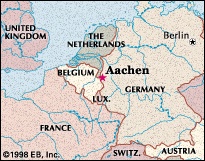Aachen
Germany
French Aix-la-Chapelle, Dutch Aken

city, North Rhine–Westphalia Land (state), western Germany. Its municipal boundaries coincide on the west with the frontiers of Belgium and The Netherlands (Netherlands, The). It was a royal residence of the emperor Charlemagne, and it served as the principal coronation site of Holy Roman emperors and of German kings from the Middle Ages to the Reformation. The Palatine Chapel, a masterpiece of Carolingian architecture, is incorporated within Aachen Cathedral (Palatine Chapel), which was designated a UNESCO World Heritage site in 1978.
Originally a Roman spa called Aquisgranum, Aachen rose to prominence in the late 8th century during the rule of Charlemagne, becoming his favourite residence and a centre of Western culture and learning. From the coronation of Otto I in 936 until the 16th century, more than 30 German emperors and kings were crowned at Aachen. Aachen was fortified in the late 12th century and granted municipal rights in 1166 and 1215, and it became a free imperial city about 1250. Aachen began to decline in the 16th century. It was too remote from the centre of Germany to be convenient as a capital, and in the 1560s the coronation site was changed to Frankfurt am Main. Aachen was frequently at odds with the emperors during the Protestant Reformation. In 1656 the city was devastated by a great fire.
Aachen hosted several peace conferences, including those ending the War of Devolution (Devolution, War of) (1668) and the War of the Austrian Succession (Austrian Succession, War of the) (1748). Occupied by Napoleon's army in 1794 and annexed by France in 1801, it was given to Prussia after the Congress of Vienna (Vienna, Congress of) (1814–15). The city was briefly occupied by the Belgians after World War I. It was severely damaged in World War II, and it became the first large German city to fall to the Allies (October 20, 1944).
The noteworthy medieval churches of St. Foillan, St. Paul, and St. Nicholas were destroyed or heavily damaged during World War II, but their reconstruction began almost immediately afterward. The Rathaus (town hall), built about 1530 on the ruins of Charlemagne's palace and containing the magnificent Hall of the Emperors, was also damaged and restored.
 Aachen Cathedral suffered relatively little damage in the war. It incorporates the distinctive Carolingian and Gothic styles. The Palatine Chapel (built 790–805) of Charlemagne, modeled on San Vitale (in Ravenna, Italy), is Carolingian in style, and the choir (c. 1355) and subsidiary chapels are Gothic. In the gallery of the chapel is the marble throne thought to have been Charlemagne's; it was long used for coronations. Charlemagne's tomb is marked by a stone slab over which hangs a bronze chandelier presented by Frederick I Barbarossa in 1168. The cathedral treasury contains examples of fine medieval workmanship and sacred relics (including the supposed swaddling clothes of Jesus, as well as his crucifixion loin cloth) that are displayed to pilgrims every seven years (see Palatine Chapel).
Aachen Cathedral suffered relatively little damage in the war. It incorporates the distinctive Carolingian and Gothic styles. The Palatine Chapel (built 790–805) of Charlemagne, modeled on San Vitale (in Ravenna, Italy), is Carolingian in style, and the choir (c. 1355) and subsidiary chapels are Gothic. In the gallery of the chapel is the marble throne thought to have been Charlemagne's; it was long used for coronations. Charlemagne's tomb is marked by a stone slab over which hangs a bronze chandelier presented by Frederick I Barbarossa in 1168. The cathedral treasury contains examples of fine medieval workmanship and sacred relics (including the supposed swaddling clothes of Jesus, as well as his crucifixion loin cloth) that are displayed to pilgrims every seven years (see Palatine Chapel).Other notable landmarks are the Suermondt Ludwig Museum and the fountain, surmounted by a statue of Charlemagne, in the market square. The International Newspaper Museum has exhibits of newspapers from the 16th century to the present. There are numerous educational institutions, including the Rhenish-Westphalian Technical University, founded in 1870, the earliest in Prussia. The nearby hot springs are much frequented; Schwertbad-Quelle, in the suburb of Burtscheid, is the warmest spring in Germany, with an average high water temperature of 169 °F (76 °C).
Aachen is a rail hub and the industrial and commercial centre of a brown-coal-mining region; almost every type of heavy industry functions in the vicinity. Manufactured products include machinery, electronics, chemicals, plastics, textiles, glass, cosmetics, and needles and pins. Pop. (2003 est.) 256,605.
- Sir Keith Macpherson; and Smith Smith, Sir Ross Macpherson
- Sir Keith Sinclair
- Sir Kenelm Digby
- Sir Kenneth MacMillan
- Sir Kingsley Amis
- Sir Lawrence Alma-Tadema
- Sir Lawrence Bragg
- Sir Leander Starr, Baronet Jameson
- Sir Leander Starr Jameson, Baronet
- Sir Lennox Berkeley
- Sir Leonard Hutton
- Sir Leonard Woolley
- Sir Leslie Stephen
- Sir Leslie Ward
- Sir Lewis Bernstein Namier
- Sir Louis-Hippolyte, Baronet LaFontaine
- Sir Louis-Hippolyte LaFontaine, Baronet
- Sir Lynden Oscar Pindling
- Sir Macfarlane Burnet
- Sir Mackenzie Bowell
- Sir Malcolm Bradbury
- Sir Malcolm Campbell
- Sir Malcolm Sargent
- Sir Marc Isambard Brunel
- Sir Mark, 6th Baronet Sykes